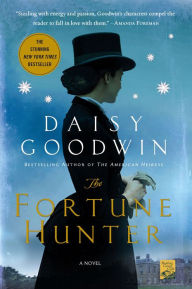 In The Fortune Hunter Daisy Goodwin has crafted a tale that weaves together fiction with historical fact. At the core of this novel is a love triangle between the handsome and dashing British Captain Bay Middleton, a young heiress by the name of Charlotte Baird, and Empress Elizabeth of Austria-Hungary, known as Sisi to her family and friends. Sisi, a romantic and tragic figure in life, was famed for her beauty, her slender and athletic figure, and for her ankle length hair that required hours of dressing daily. Goodwin does a good job capturing these features in her portrayal of the Empress, who in this novel is a 37 year old mother, still quite lovely, but anxious about and protective of her appearance, very aware that her looks were starting to fade. Sisi is portrayed as an accomplished horsewoman, clever conversationalist, and independent thinker, ready to spurn convention in favor of her own needs and desires. A good historical novel always leaves the reader wanting to know more about the characters and events which inspired the tale, and that is definitely the case with The Fortune Hunter, which sent me on a search for photographs and biographical material to get a better understanding of the history behind the novel. For anyone interested, there is much to be found online about the Empress.
In The Fortune Hunter Daisy Goodwin has crafted a tale that weaves together fiction with historical fact. At the core of this novel is a love triangle between the handsome and dashing British Captain Bay Middleton, a young heiress by the name of Charlotte Baird, and Empress Elizabeth of Austria-Hungary, known as Sisi to her family and friends. Sisi, a romantic and tragic figure in life, was famed for her beauty, her slender and athletic figure, and for her ankle length hair that required hours of dressing daily. Goodwin does a good job capturing these features in her portrayal of the Empress, who in this novel is a 37 year old mother, still quite lovely, but anxious about and protective of her appearance, very aware that her looks were starting to fade. Sisi is portrayed as an accomplished horsewoman, clever conversationalist, and independent thinker, ready to spurn convention in favor of her own needs and desires. A good historical novel always leaves the reader wanting to know more about the characters and events which inspired the tale, and that is definitely the case with The Fortune Hunter, which sent me on a search for photographs and biographical material to get a better understanding of the history behind the novel. For anyone interested, there is much to be found online about the Empress.
The Fortune Hunter focuses on a visit Sisi made to England in order to participate in the very popular aristocratic sport of fox hunting. Her English guide, Bay Middleton, rides out with her daily and is quickly impressed by her equestrian skills and daring in the saddle. Before long he falls under the thrall of her beauty and charm and they become lovers. Charlotte Baird, the third member of the love triangle, is an intelligent but impressionable young woman, inexperienced and naïve. She quickly falls in love with Bay Middleton at the start of the novel and they enter into an ‘understanding’. This relationship is then brought into question when Charlotte discovers Sisi’s attraction for Bay. Charlotte will inherit a fortune when she comes of age, and through small hints and subtle suggestions we are led to doubt the motives of Middleton in courting her. Is he indeed a fortune hunter, as the title indicates, or does he have more noble aims?
The novel is clearly written by someone who is acquainted with nineteenth century life, its customs and interests. The author chose to cast Charlotte Baird as an amateur photographer, linking the character to one of the more popular pursuits of the century. The photographs described in the novel bring to mind the work of famed Victorian photographer Julia Margaret Cameron and her peers who staged scenes from well-known poets like Tennyson, draping and posing their subjects to create suggestive and moody ‘artistic’ compositions.
Overall, I enjoyed The Fortune Hunter, even though I was disappointed by the book’s ending, which was more than a little preposterous (not to mention embarrassing for the main characters), seemingly pulled straight from the pages of a romance novel or the Broadway musical stage. The book is light and easy reading and anyone with an interest in nineteenth century culture and manners, or a curiosity about the famed Austrian empress Sisi, will find much of interest in it.


